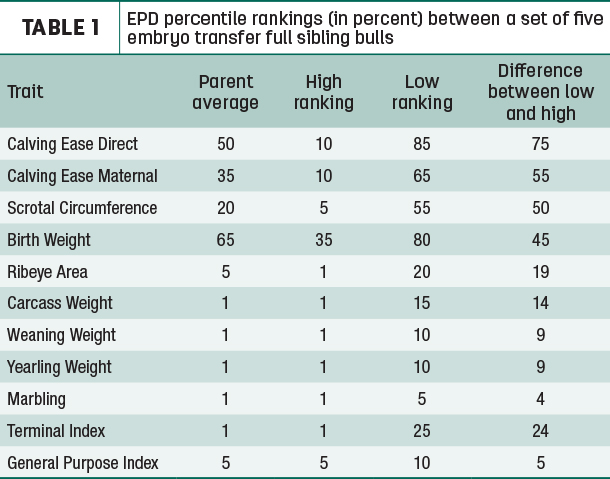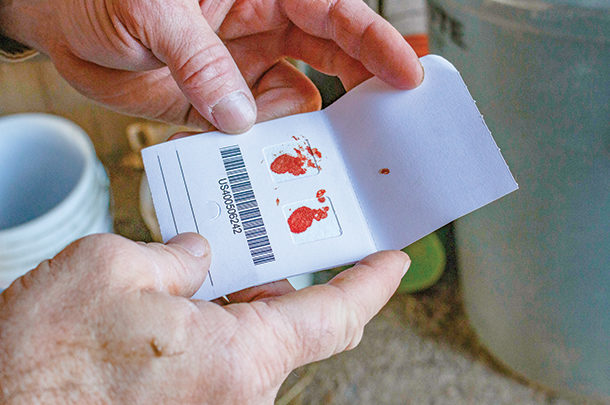DNA testing using thousands of markers, called genomic prediction, has arrived in the beef industry, and it isn’t going anywhere. But why should cattle producers, especially seedstock breeders, use this technology?
We often talk about the benefits of genomic predictions. Mainly, we discuss that genomic testing increases the accuracy of our selection decisions. Genomic-enhanced EPDs are more accurate than pedigree-based EPDs. Genomic predictions provide the same amount of information as the first calf crop out of a bull (10 to 20 calves, depending on the trait predicted).
Genomics reduces the risk of making an unlucky purchasing decision. On sale day, we make the best decision possible, given the information we have. If we only have parent average EPDs, there is a large chance the predicted EPDs will change when more data is reported. In other words, low-accuracy EPDs have a large probability to change (large possible change values). As we add in more data to the evaluation, the EPD becomes more accurate with less chance to change. Thus, genomic-enhanced EPDs reduce our risk of making an unlucky decision because the EPD is less likely to change.
However, genomic-enhanced EPDs have changed how we market cattle. Before 2010, embryo transfer full siblings (i.e., flush mates) had identical EPDs when marketed as yearlings or 2-year-olds. These identical EPDs were simply averages of the parents’ EPDs. This is because we typically don’t use performance data from embryo transfer calves as they are raised by recipient cows (not their dam). This allowed all of the flush mates to be marketed as superior breeding animals. Genomic testing has changed this.

Genomic testing allows us to identify the genetic differences between full siblings, adding accuracy to the EPDs of flush mates. It also means the EPDs of full siblings are not identical. Previously, marketers could sell flush mates for similar prices. Now because of the genomic information, full siblings can have vastly different EPDs.
First of all, the amount of genetic differences we see between full siblings is completely in line with biology. Half of the genetic variation in an entire breed can be observed between full siblings (see an eBEEF, fact sheet for more information: Extension, University of Missouri). The genomic test is doing exactly what it was designed to do.
I would challenge marketers and seedstock producers to change how they view genomic testing. Genomic predictions allow seedstock producers to market cattle with greater information. This greater information provides better customer service to the buyer. In a way, genomic testing allows us to market cattle with greater integrity because the genetic predictions are more accurate.
Genomically testing females allows cattle producers to improve their herds more rapidly. When seedstock producers DNA test bulls, they provide a higher level of customer service. Their buyers can purchase bulls with less risk and more confidence.
Let us look at a set of embryo transfer full brothers from a popular beef breed. If these bulls would have been marketed prior to genomic technology in the beef industry, they all would have been marketed as having breed-average calving ease (50th percentile). After DNA testing, the top bull had exceptional Calving Ease Direct, ranking in the top 10% of the breed. This bull can confidently be used to breed heifers.
The bottom bull now ranks in the 85th percentile (bottom 15%) and should only be used on mature cows. However, this bull that ranks low for calving ease is predicted to produce calves that will be $16 more profitable per calf in a terminal setting (feedlot and carcass) than the calves out of the high-ranking calving ease bull. Both bulls are very different; genomics identifies these differences. Both bulls have value in the beef industry – they should simply be used in different scenarios to meet different needs.
Marketing with information and integrity is not limited to seedstock producers. Commercial beef producers now have various options to market their calf crop based on genetic information. This genetic information can either come from DNA tests or sire and grand-sire genetic values. Commercial producers can DNA test a random sample of heifers or all of their heifers to identify the average genetic merit.
This information can, of course, be used to select replacement females. Additionally, the average genetic merit of the heifers equals the average genetic merit of the steers. Now we know the genetic potential of the steers without DNA testing a single steer. This genomic information can be used to more aggressively market the steers for a premium.
We all hate when we have been sold something and it doesn’t match what we were promised. The information from genomic testing allows marketers, seedstock producers and commercial operations to represent cattle more accurately. This reduces the risk that the progeny out of an animal will not live up to the predictions from sale day. This not only allows buyers to be more comfortable with their decisions, it also allows sellers to be more confident in the cattle they are selling.
Genomic testing is having an impact on the beef industry. The technology works, thus it is being used. Over half of all newly registered Angus cattle are now DNA tested for genomic-enhanced EPDs. What is now needed is for us to change our business practices so they match current capabilities of the technology.
PHOTO: DNA testing increases the accuracy of selection decisions. Photo by Cassidy Woolsey.








